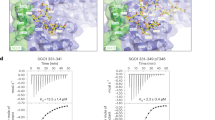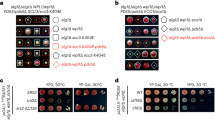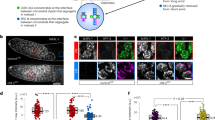Abstract
Timely dissolution of sister-chromatid cohesion in mitosis ensures accurate chromosome segregation to guard against aneuploidy and tumorigenesis. The complex of shugoshin and protein phosphatase 2A (SGO1–PP2A) protects cohesin at centromeres from premature removal by mitotic kinases and WAPL in prophase. Here we address the regulation and mechanism of human SGO1 in centromeric cohesion protection, and show that cyclin-dependent kinase (CDK)-mediated, mitosis-specific phosphorylation of SGO1 activates its cohesion-protection function and enables its direct binding to cohesin. The phospho-SGO1-bound cohesin complex contains PP2A, PDS5 and hypophosphorylated sororin, but lacks WAPL. Expression of non-phosphorylatable sororin bypasses the requirement for SGO1–PP2A in centromeric cohesion. Thus, mitotic phosphorylation of SGO1 targets SGO1–PP2A to cohesin, promotes dephosphorylation of PDS5-bound sororin and protects centromeric cohesin from WAPL. PP2A-orchestrated, site-selective dephosphorylation of cohesin and its regulators underlies centromeric cohesion protection.
This is a preview of subscription content, access via your institution
Access options
Subscribe to this journal
Receive 12 print issues and online access
$209.00 per year
only $17.42 per issue
Buy this article
- Purchase on Springer Link
- Instant access to full article PDF
Prices may be subject to local taxes which are calculated during checkout








Similar content being viewed by others
Change history
20 December 2012
In the version of this Article initially published online and in print, the protein WAPL was mistakenly written as 'WAP1'.
References
Nasmyth, K. Cohesin: a catenase with separate entry and exit gates? Nat. Cell Biol. 13, 1170–1177 (2011).
Peters, J. M., Tedeschi, A. & Schmitz, J. The cohesin complex and its roles in chromosome biology. Genes Dev. 22, 3089–3114 (2008).
Onn, I., Heidinger-Pauli, J. M., Guacci, V., Unal, E. & Koshland, D. E. Sister chromatid cohesion: a simple concept with a complex reality. Annu. Rev. Cell Dev. Biol. 24, 105–129 (2008).
Sherwood, R., Takahashi, T. S. & Jallepalli, P. V. Sister acts: coordinating DNA replication and cohesion establishment. Genes Dev. 24, 2723–2731 (2010).
Rankin, S., Ayad, N. G. & Kirschner, M. W. Sororin, a substrate of the anaphase-promoting complex, is required for sister chromatid cohesion in vertebrates. Mol. Cell 18, 185–200 (2005).
Schmitz, J., Watrin, E., Lenart, P., Mechtler, K. & Peters, J. M. Sororin is required for stable binding of cohesin to chromatin and for sister chromatid cohesion in interphase. Curr. Biol. 17, 630–636 (2007).
Rolef Ben-Shahar, T. et al. Eco1-dependent cohesin acetylation during establishment of sister chromatid cohesion. Science 321, 563–566 (2008).
Unal, E. et al. A molecular determinant for the establishment of sister chromatid cohesion. Science 321, 566–569 (2008).
Rowland, B. D. et al. Building sister chromatid cohesion: SMC3 acetylation counteracts an antiestablishment activity. Mol. Cell 33, 763–774 (2009).
Zhang, J. et al. Acetylation of SMC3 by Eco1 is required for S phase sister chromatid cohesion in both human and yeast. Mol. Cell 31, 143–151 (2008).
Nishiyama, T. et al. Sororin mediates sister chromatid cohesion by antagonizing WAPL. Cell 143, 737–749 (2010).
Lafont, A. L., Song, J. & Rankin, S. Sororin cooperates with the acetyltransferase Eco2 to ensure DNA replication-dependent sister chromatid cohesion. Proc. Natl Acad. Sci. USA 107, 20364–20369 (2010).
Waizenegger, I. C., Hauf, S., Meinke, A. & Peters, J. M. Two distinct pathways remove mammalian cohesin from chromosome arms in prophase and from centromeres in anaphase. Cell 103, 399–410 (2000).
Hauf, S. et al. Dissociation of cohesin from chromosome arms and loss of arm cohesion during early mitosis depends on phosphorylation of SA2. PLoS Biol. 3, e69 (2005).
Kueng, S. et al. WAPL controls the dynamic association of cohesin with chromatin. Cell 127, 955–967 (2006).
Dreier, M. R., Bekier, M. E. II & Taylor, W. R. Regulation of sororin by CDK1-mediated phosphorylation. J. Cell Sci. 124, 2976–2987 (2011).
Zhang, N., Panigrahi, A. K., Mao, Q. & Pati, D. Interaction of sororin protein with polo-like kinase 1 mediates resolution of chromosomal arm cohesion. J. Biol. Chem. 286, 41826–41837 (2011).
Tang, Z. et al. PP2A is required for centromeric localization of SGO1 and proper chromosome segregation. Dev. Cell 10, 575–585 (2006).
Tang, Z., Sun, Y., Harley, S. E., Zou, H. & Yu, H. Human Bub1 protects centromeric sister-chromatid cohesion through Shugoshin during mitosis. Proc. Natl Acad. Sci. USA 101, 18012–18017 (2004).
Kitajima, T. S., Hauf, S., Ohsugi, M., Yamamoto, T. & Watanabe, Y. Human Bub1 defines the persistent cohesion site along the mitotic chromosome by affecting Shugoshin localization. Curr. Biol. 15, 353–359 (2005).
Kitajima, T. S. et al. Shugoshin collaborates with protein phosphatase 2A to protect cohesin. Nature 441, 46–52 (2006).
Gandhi, R., Gillespie, P. J. & Hirano, T. Human WAPL is a cohesin-binding protein that promotes sister-chromatid resolution in mitotic prophase. Curr. Biol. 16, 2406–2417 (2006).
Karamysheva, Z., Diaz-Martinez, L. A., Crow, S. E., Li, B. & Yu, H. Multiple anaphase-promoting complex/cyclosome degrons mediate the degradation of human SGO1. J. Biol. Chem. 284, 1772–1780 (2009).
Xu, Z. et al. Structure and function of the PP2A-shugoshin interaction. Mol. Cell 35, 426–441 (2009).
Tanno, Y. et al. Phosphorylation of mammalian Sgo2 by Aurora B recruits PP2A and MCAK to centromeres. Genes Dev. 24, 2169–2179 (2010).
McGuinness, B. E., Hirota, T., Kudo, N. R., Peters, J. M. & Nasmyth, K. Shugoshin prevents dissociation of cohesin from centromeres during mitosis in vertebrate cells. PLoS Biol. 3, e86 (2005).
Riedel, C. G. et al. Protein phosphatase 2A protects centromeric sister chromatid cohesion during meiosis I. Nature 441, 53–61 (2006).
Domingo-Sananes, M. R., Kapuy, O., Hunt, T. & Novak, B. Switches and latches: a biochemical tug-of-war between the kinases and phosphatases that control mitosis. Phil. Trans. R. Soc. B 366, 3584–3594 (2011).
Solomon, D. A. et al. Mutational inactivation of STAG2 causes aneuploidy in human cancer. Science 333, 1039–1043 (2011).
Orth, M. et al. Shugoshin is a Mad1/Cdc20-like interactor of Mad2. EMBO J. 30, 2868–2880 (2011).
Llano, E. et al. Shugoshin-2 is essential for the completion of meiosis but not for mitotic cell division in mice. Genes Dev. 22, 2400–2413 (2008).
Kawashima, S. A., Yamagishi, Y., Honda, T., Ishiguro, K. & Watanabe, Y. Phosphorylation of H2A by Bub1 prevents chromosomal instability through localizing shugoshin. Science 327, 172–177 (2010).
Yamagishi, Y., Honda, T., Tanno, Y. & Watanabe, Y. Two histone marks establish the inner centromere and chromosome bi-orientation. Science 330, 239–243 (2010).
Wu, F. M., Nguyen, J. V. & Rankin, S. A conserved motif at the C terminus of sororin is required for sister chromatid cohesion. J. Biol. Chem. 286, 3579–3586 (2011).
Wu, N. et al. SCC1 sumoylation by Mms21 promotes sister chromatid recombination through counteracting WAPL. Genes Dev. 26, 1473–1485 (2012).
Acknowledgements
We thank Y. Li and the Protein Chemistry Core at UT Southwestern Medical Center for mass spectrometry analysis of phospho-SGO1. We also thank J. Chen (Oklahoma Medical Research Foundation, USA) for making the sororin antibody and J-M. Peters (Research Institute of Molecular Pathology, Vienna, Austria) for providing the phospho-S1224-SA2 antibody. S.R. was financially supported by grant RR016478 from the National Center for Research Resources (NCRR), a component of the National Institutes of Health (NIH), and is a Pew Scholar in the Biomedical Sciences. H.Y. is an Investigator with the Howard Hughes Medical Institute and is supported by grants from the Welch Foundation (I-1441) and the Cancer Prevention Research Institute of Texas (RP110465).
Author information
Authors and Affiliations
Contributions
H.L. designed and performed all experiments and analysed the data. H.Y. supervised the project and analysed the data. S.R. provided key reagents and analysed the data. H.L. and H.Y. wrote the paper.
Corresponding author
Ethics declarations
Competing interests
The authors declare no competing financial interests.
Supplementary information
Supplementary Information
Supplementary Information (PDF 1604 kb)
Rights and permissions
About this article
Cite this article
Liu, H., Rankin, S. & Yu, H. Phosphorylation-enabled binding of SGO1–PP2A to cohesin protects sororin and centromeric cohesion during mitosis. Nat Cell Biol 15, 40–49 (2013). https://doi.org/10.1038/ncb2637
Received:
Accepted:
Published:
Issue Date:
DOI: https://doi.org/10.1038/ncb2637
This article is cited by
-
The Caenorhabditis elegans Shugoshin regulates TAC-1 in cilia
Scientific Reports (2023)
-
Genome control by SMC complexes
Nature Reviews Molecular Cell Biology (2023)
-
Cohesin-protein Shugoshin-1 controls cardiac automaticity via HCN4 pacemaker channel
Nature Communications (2021)
-
The structural basis for cohesin–CTCF-anchored loops
Nature (2020)
-
SWITCH 1/DYAD is a WINGS APART-LIKE antagonist that maintains sister chromatid cohesion in meiosis
Nature Communications (2019)



